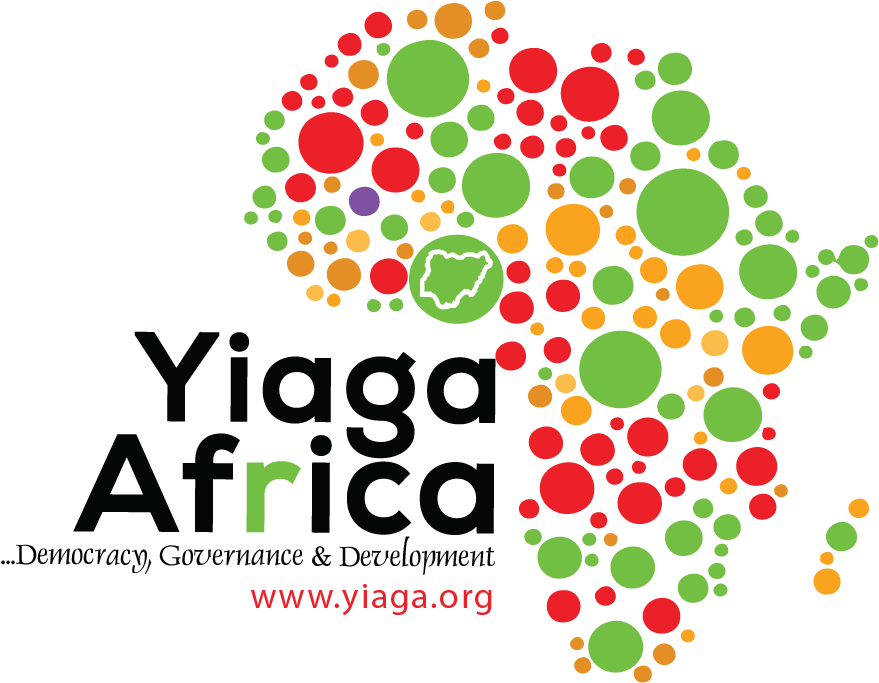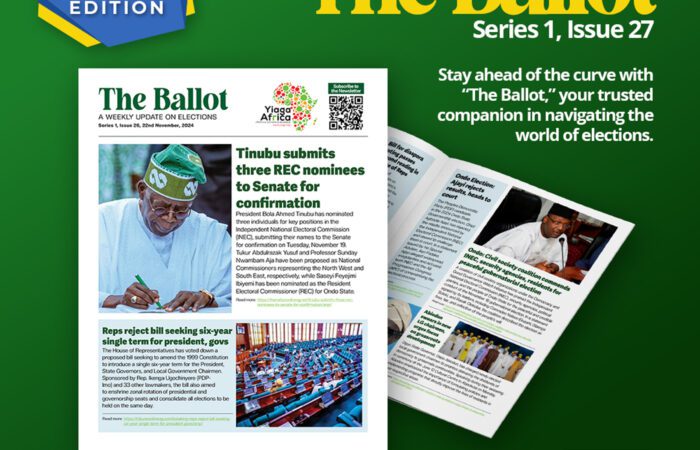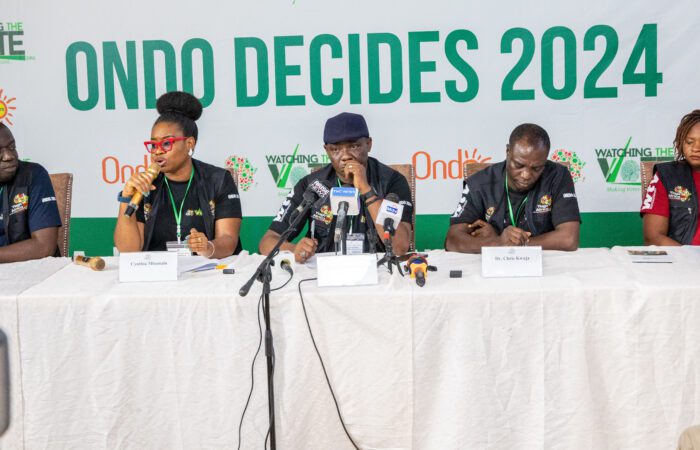Introduction
Ladies and Gentlemen, it gives us great pleasure to welcome you to the Youth Initiative for Advocacy, Growth & Advancement (YIAGA) WatchingTheVote (WTV) Preliminary Statement on the Process of the 2017 governorship election in Anambra. This press briefing is the third in series hosted by YIAGA WTV for the 2017 Anambra governorship election. This briefing covers preliminary findings about the conduct of accreditation, voting, and counting. Although YIAGA has received data from 243 of 250 (97%) sampled polling units and currently has stable estimates for the election outcome, it is the Independent National Electoral Commission (INEC) that has the mandate to announce election results. As soon as INEC releases the results, YIAGA will follow up with a fourth press briefing IMMEDIATELY after INEC announces the official results of the Anambra gubernatorial election to issue its verification statement on whether the official results reflect the ballots cast at polling units.
Yesterday, the people of Anambra state went to the polls to elect a governor that will lead the state for the next four years. YIAGA WTV observers witnessed enthusiastic commitment of fellow Anambrarians to democratic processes and the possibility of determining the leadership of the state through peaceful, transparent and credible elections. The YIAGA WTV recognizes that voters by and large conducted themselves in a peaceful and orderly manner on election day and urges politicians across the spectrum to recognize and respect this public manifestation of citizens’ commitment to the democratic process.
WTV data is based on the parallel vote tabulation (PVT) methodology – the gold standard for citizen election observation. On Election Day, WTV deployed 500 stationary observers to a representative statistical sample of 250 polling units and 29 mobile observers in all 21 local government areas (LGAs) of Anambra state. This enabled YIAGA to provide timely and accurate information on the conduct of accreditation, voting, and counting as well as to independently verify the official results for the Anambra gubernatorial election as announced by INEC. The preliminary report on the conduct of accreditation, voting, and counting is based on reports from 243 of 250 (97%) sampled polling units. YIAGA continues to receive reports from its observers on ground and will include this data in its final report.
YIAGA undertook WTV to provide the public, governorship candidates, political parties, and INEC with independent information on the conduct of the election and to help ensure the official results for the Anambra gubernatorial election truly reflect the ballots cast at polling units. If the announced results reflect the ballots cast at polling units then we will confirm the outcome. However, if the announced results have been manipulated and do not match the results posted at polling units then, YIAGA will expose it.
Pre-Election Period and Electoral Environment
As part of our efforts to deepen electoral integrity, YIAGA launched the Pre-Election Observation (PREO) component of the WTV project in September 2017. Under the PREO, YIAGA collected pre-election environment data from long-term observers (LTOs) in all 21 LGAs in Anambra.
Key findings included: increase in INEC level of preparedness over time; insufficient voter education messages targeting youth, women, and persons with disabilities (PWDs); the prevalence of gender, faith and age based hate speech; few reports of violent physical or verbal attack on party rallies or meetings, but some incidents of vandalism and destruction of property; high levels of registration by women and youth; and campaigning predominantly by four political parties – All Progressives Congress (APC); All Progressives Grand Alliance (APGA); Peoples Democratic Party (PDP), and United Progressive Party (UPP).
On the eve of election day, YIAGA raised awareness of three critical issues: the need for adequate and professional security across the state and particularly in “black spots”; the need for polling officials to ensure official results are publicly posted at all polling units using INEC FORM EC 60E; and for INEC to provide access to observers, political parties, and the media to all collations centres at the ward, LGA, and state level.
YIAGA WTV also observed the deployment of election materials from the State headquarters of INEC to its local government offices.
#WatchingTheVote Election Day Observation
YIAGA’s WTV initiative employed the parallel vote tabulation (PVT) methodology for Election Day observation. This is the gold standard for citizen observation and provides accurate and timely information on the conduct of the accreditation, voting, and counting at polling units and is able to independently verify the accuracy of official election results. For the PVT, YIAGA deployed 500 trained and accredited stationary observers in teams of two to a representative statistical sample of polling units across Anambra.
The sampled polling units were determined by established statistical principles to ensure the resulting information is representative of the state and unbiased. The sample includes polling stations in every one of the 21 LGAs in Anambra. The number of sampled polling units in each LGA is based on the percentage of polling units and registered voters in the LGA. For example, Aguata LGA has 6.5% of all the polling units in Anambra (300 of 4,608) and 6.8% (17 of 250) of the sampled polling units in Aguata LGA.
500 stationary observers and 29 mobile observers were carefully recruited according to established criteria to ensure that they are independent and non-partisan. All YIAGA citizen observers had to sign a pledge of neutrality and were given a code of conduct to which they must adhere when observing.
YIAGA’s WTV observers witnessed the entire process on Election Day. They deployed to polling units at 7:00am and observed setup, accreditation, voting, and counting. Throughout the day, they sent in coded text messages containing their observation reports. Every stationary observer sent in ten coded text messages to YIAGA’s data centre located here at Finotel Hotel, Awka, Anambra.
As noted, the PVT methodology will also enable YIAGA to independently verify the accuracy of the official results for the Anambra gubernatorial election. YIAGA will issue its statement on the verification of the official results immediately after INEC announces the outcome of the Anambra gubernatorial election.
Primary Election Day Findings
YIAGA’s preliminary findings are based on reports from 243 polling units from a representative statistical sample of 250 polling units (97%).
Setup
- As of 7:30am INEC officials had arrived at 28% of polling units.
- As of 10:00am 75% of polling units were open while by 12:00 noon 92% of polling units were open.
- The average number of polling officials was four (4) while the average number of female polling officials was two (2).
- Almost 98% of polling units had card readers.
- Almost 100% of polling units had all other sensitive materials.
- During setup, party agents for the APC were at 89% of polling units; party agents for APGA were at 96% of polling units; and polling agents PDP were at 87% of polling units.
Accreditation and Voting
- At 77% of polling units the card reader functioned throughout the day.
- At 98% of polling units every potential voter’s fingers were checked for indelible ink before being permitted to vote.
- At 93% of polling units every potential voter’s permanent voter card (PVC) was checked by the card reader. At 93% of polling units every potential voter’s PVC was checked against the register of voters. At 97% of polling units no one was accredited to vote who did not have a PVC.
- At 89% of polling units every potential voter’s fingerprints were checked by the card reader.
- While nearly three (3) of every (4) voters had both their PVC and finger prints authenticated by the card reader, approximately one (1) in four (4) voters were permitted to vote even though their fingerprints were not authenticated and only their PVC was authenticated by the card reader.
- 92% of polling units were set up so no one could see how the voters marked their ballot papers. However, at 14% of polling units it was possible to see how a voter’s ballot paper was marked when it was put in the ballot box.
- At 99% of polling units indelible ink was applied to the cuticle of a finger of every accredited voter.
- During accreditation and voting, at 17% of polling units voters crowded the polling officials, at 11% of polling units there were attempts by people to influence the polling officials, and at 6% of polling stations there were incidents of intimidation, harassment or violence.
- 13% of polling units completed accreditation and voting by the designated time of 2:00pm while by 3:00pm 82% of polling units had completed accreditation and voting.
Counting
- At 98% of polling units the polling officials showed how every ballot paper was marked to everyone present.
- At 90% of polling units the polling officials sorted the ballot papers into piles by political party and rejected ballots.
- At 22% of polling units the ballot papers were counted more than once.
- During counting, at 4% of polling units someone attempted to influence the polling officials and at 4% of polling units there were incidents of intimidation or harassment.
- At 93% of polling units the official results were posted for the public to see.
Turnout
YIAGA estimates that turnout for the Anambra 2017 gubernatorial election will be between 21% and 25% based on official turnout figures collected from the PVT’s representative statistical sample of polling units across the 21 LGAs in the state. If INEC’s official turnout falls within WTV’s estimated range then it accurately reflects the ballots cast at polling units.
Critical Incidents
YIAGA established a Critical Incident desk to receive urgent reports about serious problems arising on Election Day. As appropriate, YIAGA shared information with INEC as well as security officials so that steps could immediately be taken to resolve any incidents.
Over the course of Election Day, the data centre received 36 confirmed critical incidents reports. The distribution of critical incidents by senatorial district is: six (6) from Anambra Central, four (4) from Anambra North, and 26 from Anambra South. The most common critical incidents were 14 cases of card reader malfunction and six (6) cases of vote buying or bribery.
Observations
Based on our data provide by 500 WTV observers deployed to 250 polling units across all 21 LGAs, YIAGA WTV makes the following observations;
- Election logistics: The management of election logistics for the election was significantly poor especially in rural areas. For Awka North and Awka South LGAs INEC officials arrived 67% and 69% of polling units by 7:30 am while the average for the state was only 28%. This relates to the early deployment of sensitive materials from the local government offices to the Registration Area centres and polling units. From our data, it is obvious that the registration area camps (RAC) were not activated in some LGAs due to absence of security personnel or poor transportation arrangements by INEC. When compared to the 2013 Anambra governorship election data, YIAGA WTV notes a trend of poor management of deployment of election materials. In 2013, only 39% of polling units recorded arrival at 7:30am.
- Accreditation of voters using the card readers: The perennial challenges of failure of the card reader to authenticate fingerprints of registered voters remains prevalent. Our data suggests that some voters were accredited to vote without fingerprint authentication. Approximately, one (1) in four (4) voters were accredited even though the card reader could not authenticate their fingerprints and only their PVC was authenticated by the card reader.
- Poor Voter turnout: Our voter turnout estimates suggests poor turnout for the elections – between 21% and 25%. This presents a disturbing trend as governments are instituted by a small fraction of the voting population who turn out to vote on election day. In 2013, the gubernatorial election turnout was similarly low with only 26.3% of registered voters going to the polls.
- Secrecy of the ballot, vote buying and bribery: The secrecy of the ballot remains a cardinal feature of democratic elections. Evidence abound that the secrecy of the ballot in this election was undermined in some polling units. This created an opportunity for vote buying across some polling units observed. There were also cases of bribery of election officials. These illegal acts occurred in the presence of security officials who made no arrests or attempts to abate the illegality.
Emerging Concern
- Results collation: YIAGA WTV has received reports of attempts by stakeholders especially politicians to compromise the results collation process at the local government collation centres. The transparency of the collation process is critical for the success of this election. We’d like to inform all stakeholders, that YIAGA WTV has its estimates for the election results based on the untainted official results collected form the polling units. Therefore we are able to expose and manipulation of the results at either ward or LGA collation centres.
Download Full Report Below






